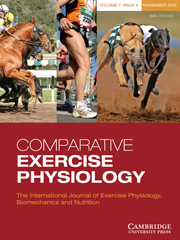Article contents
Phenylbutazone blocks the cytokine response following a high-intensity incremental exercise challenge in horses
Published online by Cambridge University Press: 07 January 2011
Abstract
This study tested the hypothesis that phenylbutazone would block the exercise-induced increase in cytokine markers of inflammation in blood. Blood samples were obtained from unfit Standardbred mares (age 10 ± 4 years, ~500 kg) before and after three different trials (standing control (CON), n = 9; exercise with phenylbutazone (EX-bute), n = 9; and exercise with water, n = 9). Comparisons were made for data collected in three trials, one where each horse underwent an incremental exercise test (graded exercise test (GXT)) where they were administered water as a placebo, a GXT following phenylbutazone administration (2 g given orally 2 h before the GXT) or standing parallel control where they stood quietly in stalls. During the GXT, horses ran on a treadmill (1 m s− 1 increases each min until fatigue, 6% grade). Blood samples were obtained 30 min before exercise, immediately after exercise and at 0.5, 1, 2, 4 and 24 h post-GXT or at matched time points during the parallel control trials. Samples were analysed using real-time PCR for measurement of mRNA expression of interferon-γ (IFN-γ), tumour necrosis factor-α (TNF-α) and interleukin (IL)-6 in samples collected during all three trials, and for IL-1 and IL-10 in samples collected for the CON and EX-bute trials. Data were analysed using ANOVA for repeated measures, and where appropriate, post hoc separation of means utilized the Student–Newman–Keuls test. The null hypothesis was rejected when P < 0.05. There were no changes (P>0.05) in IL-1, IL-6, IFN-γ or TNF-α during CON or following phenylbutazone administration. During the water trial, exercise resulted in significant increases in IFN-γ, IL-1 and TNF-α. It was concluded that high-intensity exercise results in a transient increase in the expression of inflammatory cytokines in blood that is blocked when phenylbutazone is administered to horses.
- Type
- Research Paper
- Information
- Copyright
- Copyright © Cambridge University Press 2011
References
- 4
- Cited by


